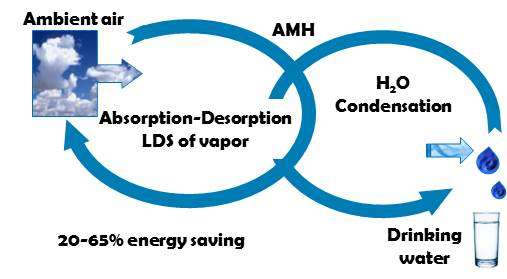
“Liquid-Desiccant Vapor Separation Reduces the Energy Requirements of Atmospheric Moisture Harvesting“
Getting clean water to communities in parched areas of the planet remains an ongoing challenge. Recent developments that harvest water from air have been proposed as a solution. However, the technology to do so consumes a lot of energy. But based on new modeling results, scientists now report in ACS’ journalEnvironmental Science & Technology that a new system design would require less energy and produce high-quality water.
The atmosphere around us contains water vapor in amounts comparable to all the surface and underground liquid freshwater on the planet, according to an International Organization for Dew Utilization study published in 2000. However, current machines that collect water from this airy reservoir have major limitations. For example, one method uses electrical refrigeration to cool the air and condense the vapor, but that consumes 40 to 90 percent of the total system’s energy requirements. Scientists from the Technion (Israel) compared this strategy to their new design that uses a liquid desiccant to first separate the vapor from air and then cool only the vapor. Their calculations show that this approach would result in 20 to 65 percent energy savings over the standard system, depending on where the technology is applied and the sites’ climate conditions.
The Latest on: Atmospheric moisture harvesting
[google_news title=”” keyword=”Atmospheric moisture harvesting” num_posts=”10″ blurb_length=”0″ show_thumb=”left”]
via Google News
The Latest on: Atmospheric moisture harvesting
- Why Your Houseplant Isn't Absorbing Water And How To Fix Iton April 27, 2024 at 12:45 pm
If you're watering your houseplant regularly but it isn't absorbing the water it needs, we may know why. We also share how to get your thirsty plant hydrated.
- The Power of Us: As EV demand slows, a new alternative fuel garners attentionon April 26, 2024 at 1:59 pm
Golub considers himself an early EV adopter, someone who's willing to deal with some of the frustrations that come with new technology. But more mainstream consumers generally have a lower tolerance ...
- Why coffee prices are poised to surge even further as food inflation rageson April 26, 2024 at 5:36 am
A supply crunch of robusta coffee beans in Vietnam — the world’s biggest producer of the bitter bean variety — is poised to send the cost of your already pricey latte even ...
- How The Home Improvement Industry Is Approaching Sustainability In An Uncertain Climateon April 23, 2024 at 1:32 pm
Get expert advice on improvements to your home, including design tips, how much you'd expect to pay for a pro and what to ask when hiring experts.
- Vietnam implements new rice farming techniques in effort to mitigate methane emissionson April 23, 2024 at 6:17 am
Vietnam is aiming to transform its rice sector, making it more resilient to climate change while also reducing its emissions of methane, a greenhouse gas.
- In Vietnam, farmers reduce methane emissions by changing how they grow riceon April 22, 2024 at 7:22 pm
Vietnam aims to transform its rice sector, making it more resilient to climate change while also reducing its emissions of methane, a greenhouse gas far more potent than carbon dioxide ...
- Last Weekend’s Political Mirageon April 22, 2024 at 3:17 pm
The passage of the Ukrainian aid package by the House this past weekend is an extraordinary sign of political courage. But in the party of Donald Trump, this win for democracy may soon seem like a ...
- Animal agriculture advances worth celebrating on Earth Dayon April 22, 2024 at 7:11 am
Earth Day serves not only as a reminder of our duty to the environment but also as an acknowledgment of the farmer's reverence for Mother Nature.
- Zimbabwe declares national disaster amid grueling drought and barren croplands: 'No [one] must succumb or die from hunger'on April 20, 2024 at 3:45 am
"No Zimbabwean must succumb or die from hunger," President Emmerson Mnangagwa said during a news conference. "To that end, I do hereby declare a nationwide state of disaster, due to the El ...
- Scientists make breakthrough with advanced technology generating water from thin air — and it could save millions of liveson April 16, 2024 at 3:00 am
Researchers in China have reportedly developed a new technology similar to hydropanels for harvesting water out of thin air that is powered by energy from the sun. The device could be especially ...
via Bing News









